TEACHING ART AT HOME: PROBLEMS, SET-UP, AND ART SUPPLIES
I am super excited about this little PDF gem, so go ahead and download it now for free!
Over the years, I have received many emails from home-schooling parents wondering how to incorporate my art lessons into their home-school curriculum. The questions range from which art supplies to use to how to adapt a lesson for different ages. I don’t have any experience as a home-school parent so I have always been reluctant to offer advice. But I got thinking and asking (thanks to my DSS Facebook group!) and have come up with some tips that might make the task of incorporating art into your home a bit easier.
From what I can tell from your emails, most of the problems associated with teaching art contains one or more of the following statements…

- I am not an artist
- I don’t know how to draw so teaching art to my children, the drawing skills feels overwhelming
- Spending 30 minutes setting up painting project for 5 minutes worth of art time seems like a waste of time
- I don’t have my art supplies in one place so it’s easier to avoid art time
- My child gets frustrated and doesn’t want to do what I teach
- Too many kids + too many ages = an organizational nightmare
- I have no idea what supplies to buy and how to use them.
- I don’t know how to teach the same lesson to all my kids
Do any of these sound familiar? I totally get it. I’m going to break down these problems and hopefully offer a solution or two.

Not an artist? That’s okay. You don’t have to be.
I started this blog hoping to help anyone interested in teaching art to children. This mantra didn’t happen overnight. Early on in my career as an art ed blogger I posted what I thought were pretty complete lesson tutorials. But my readers kept asking more and more questions. I realized that the omission of even the smallest item in a checklist of instructions could stymie someone. I totally got it. People were asking for very specific details…exact steps for teaching art in a language they understood. Why do you suppose that is?
To me, most people are attracted to a visual idea like a picture of a finished art project. Some know instinctively whether or not their child or students could do the lesson but what they don’t know is how long the project will take, how to create vibrant colors or what paper to use.
You see, even art teachers and creative people like myself ask these questions: What paint did you use? Should I use a pencil? How do I encourage children not to crumple up their paper? Very few art teachers, classroom teachers, moms and home-school moms know exactly what to teach, how to teach it and what to use.
So the first step is to be gentle on yourself and embrace art. The answers are out there and hopefully, with this post, we can continue to ask questions. Let’s start with some fundamentals…
About Drawing…
Most people have grown up or have learned to judge art by the quality of the learning experience. We tend to buy into the notion that art can be stifled, that art is only art if you draw from observation or that art is not art if a child only draws one thing. I’m being a little dramatic but I’ve heard parents worry that their child loves how-to-draw books, loves to trace action figures or doesn’t like to use chalk.
To that I say, so what? As a child I only drew girl figures and gymnasts. I traced for years and years until I understood the female form. I later became a fashion illustrator and an accomplished figure illustrator. The tracing didn’t hurt me at all. The most important component for me was interest. I was interested in a very specific drawing genre and nothing else interested me. Did that mean I wasn’t an artist? No, of course not.
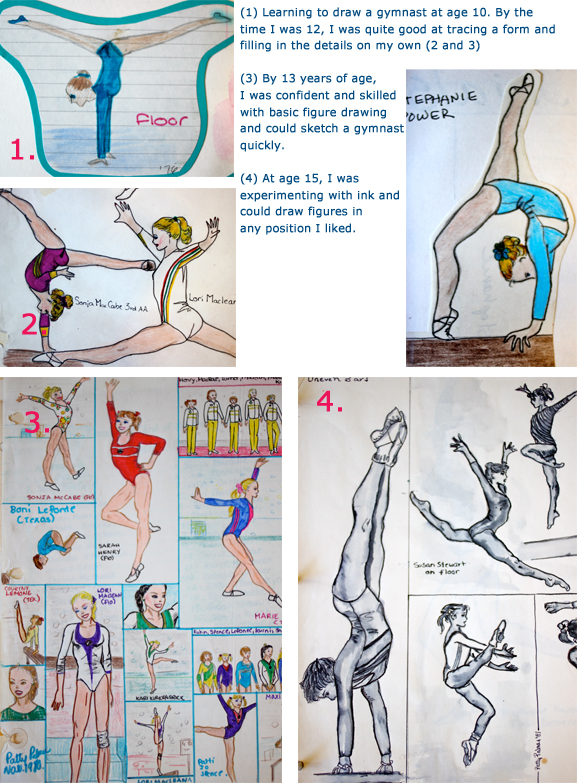
Allow a child to create art in the way he or she desires. Try not to judge what they do or how they do it. Now, try and apply the same concept to yourself. It’s okay to use how-to-draw handouts or books. It’s really fun learning this skill, and drawing is just that: a skill. Don’t be afraid to teach a child a lesson and expect him to follow along. Many children are quite enthusiastic to learn to draw or paint in a way that is new to them.
Big Tip #1: Be an Artist
You must try the art lesson yourself before introducing the lesson to your child. This works out the teaching “kinks”, gives you confidence and allows you to see where potential frustrations might occur.

You don’t need art easels but you do need a spot for each child to draw, paint and create. Kitchen tables are the best. Lay down a plastic table cloth or a large 18″ x 24″ sheet of paper per child. I use large sheets of paper in my classroom. They get a bit soggy after a paint day, but after they dry, they can be used again and again.
If you are teaching art to school-age children, it is imperative that you treat the art lesson like any other subject. To do this, you must develop a matrix of what works for you so that every time you do an art lesson, the children know what to expect. Basically, establish a consistent schedule.
Teaching at home is not unlike a classroom setting. For my younger students (K-3), the children sit on the floor while I read a book as a transition to my lesson, I show them a simple demonstration and then they go to their seats to do the art lesson. When the class is over, I ring the bell and we clean up. This happens every time they come to art class. Consistency breeds good behavior. Children know they can’t just get up in the middle of a project and run outside to play. They start to understand that there is a time and place to do all things they love.
Let the children be responsible for returning their own supplies to your storage system (more on that later).
If you are teaching to more than 3 children, your attention will be divided but don’t turn this into a problem. I teach between 20-30 children at a time and all I can say is that there are many, many developmental age groups in a classroom. Try to simplify the lesson for the youngest but don’t teach to the youngest; teach to the middle.
I’ll be honest, it’s not easy to adjust teaching art lessons for a child who is overwhelmed without actually helping him, but let’s look at an example: Self-Portraits for a Kinder, second grader and a fifth grader. You can all watch the same video, read the same portrait lesson and look in mirrors, but when it comes time to draw, I would give the youngest an oval template, the middle can start with a letter “U” and the oldest can craft a more realistic face. You don’t have to do this, but it’s important to understand that a kinder won’t be able to follow the same set of instructions as the older kid. Just adjust like you would teaching math or language. This is why I break down my lessons into grade levels. They work better that way.
I approve of and love open-ended art projects but if you have children of various ages, projects that don’t have a certain flow encourages some children to lose interest faster than others. Although this can be said about any art lessons, the more structured you are about your lesson, the more likelihood that you can control the schedule. Keep in mind that I can’t possibly know the dynamics of every home-school environment but I do believe that a little structure is good for any type of learning.
I’ve had a question from one reader who was frustrated because her home-school art group was a nightmare to manage. Her problem was that the younger children would finish early and run off outside to play while the older kids continued working. After a few lessons, more of the group began abandoning their lessons so they could go outside to play. The problem I told her was that she opened up the option of playing outside. Don’t do that.
When teaching to a group, it is very likely that all children will work at a different pace. Try to engage with all levels and provide “free-choice” activities for the children who truly finish early. This could be an art related activity that can be accomplished on their own. The trick here is to establish a set art time whether you finish the main project or not.
Now that you have your internal set-up underway, here are some logistics you may want to consider in teaching art at home:
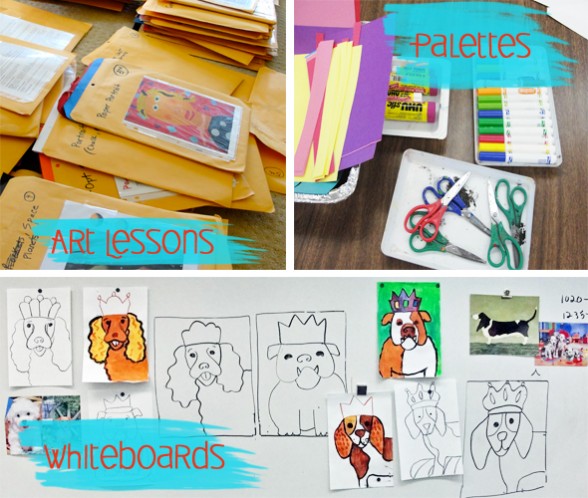
Reduce prep anxiety by encouraging children to share supplies. Place paint or coloring supplies in the middle of the table but provide a paint brush, marker or other drawing tool for each child. It’s helpful to keep general art related supplies together in a bin.

Don’t feel like you need to go “all out” when teaching art at home. Buy some basic supplies, pick a simple lesson that appeals to you and your children and don’t worry too much about the history of art, tying the lesson into your science unit or math lesson. Sometimes, it’s okay just to do art for art’s sake.
I couldn’t be teaching art without a white board. I know many teachers are using only technology in their classroom, and that’s great. But for me, using the whiteboard as a drawing space, a spot to hang art visuals and a place to post samples is critical to a rich visual space. I know you can’t have a huge whiteboard in your home, but try to find a magnetic whiteboard to hang on your wall. The bigger the better.
Print out art ideas and art lessons and place in a manilla envelope instead of keeping everything online. Sometimes, it’s easier to organize a lesson when you have something tangible. Keeping the manilla envelopes in a box allows you to add to the folders when you see a new idea on Pinterest or on one of your favorite blogs.
Big Tip #2: Be organized and offer a structured lesson when teaching art
Try to embrace art as a learning experience and not just an activity. Art is not necessarily a craft project but a lesson in learning a technique, understanding how civilization has communicated through history and expressing one’s creative self. If it’s overwhelming teaching art once a week, try once a month. Baby steps!
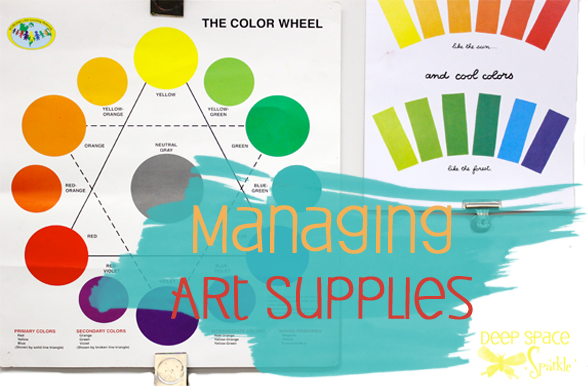
I remember when I first began teaching, I was asked to teach 7 grade levels and had one week to order art supplies and develop an art curriculum. Do you know what gave me the biggest headache? Paper! I could not figure out for the life of me what kind of paper art teachers were using. No one tells you.
The websites I perused had images of beautiful art but I was baffled with what paper the teacher used to get such amazing results. It took me over a year of sampling special papers before I realized that the paper my school stocked for the classrooms was perfect for art. What paper was that? Sulphite paper! If you have no idea what Sulphite paper is, don’t worry. I have create a special Art Supply PDF that details all you need to know about art supplies. It includes links to Blick art supplies so that you can see the product as well as read about it.
DOWNLOAD:
I am super excited about this little PDF gem, so go ahead and download it now for free!
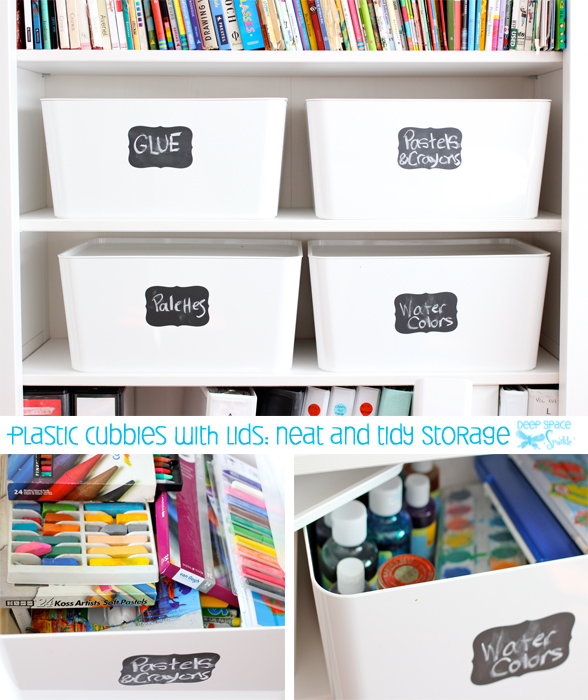
Art Storage:
Now that you know what supplies to order and what to use them for, you’ll need a place to put them. I’m going to be honest here. The more organized you are, the easier it is to teach art. It has taken me a long, long time to find the perfect storage for me. I don’t like to see art supplies in my den or on my kitchen counter. I like things tucked away, but not forgotten.
These plastic bins from Ikea are perfect! I slide them onto my shelf and when I need an art product, I slide the little cover off and pluck out what I need. You can also remove the entire bin and place it where it will be close. I bought some Martha Stewart Chalk labels at Staples to give the bins some organization appeal. You don’t need these as it is just as easy to write on each bin with a Sharpie marker (it can wash off).
Paper Storage
I use an old dresser for flat paper storage. I looked at fancy flat paper storage units but the truth is, they are very expensive. Ikea has one, but it is cheap and wobbly. You are better off buying an old dresser at a garage sale and splashing a coat of paint on it. It will hold up better.
Here’s another paper trick: don’t buy too much. All you need is the paper outlined in my art supply PDF. Stick to the basics and try not to overload your house with craft papers.
Markers, Pens and Crayons….
I like finding jars and vases around the house to store my coloring tools. Stand-up storage systems better than trays or plastic tupperware just because they are often pretty to look at. Always remove crayons, markers and colored pencils from their packaging for the simple reason that it is much easier putting these items back into a glass jar than lining them up neatly in a boxed package. Can you tell I’m a bit lazy?
Tip #3: Organize your art supplies in a way that pleases you and coordinates with your environment. I’ve read that organization advice always fails as everyone has their own unique method of organizing. I like to see some things, but not others. I have a big jar of crayons on my desk because they remind me of my childhood and my happy childhood art memories. It keeps me focused. You may hate the look, feel and smell of crayons, so my storage advice wouldn’t work for you. So, find what works for you and don’t buy too much!

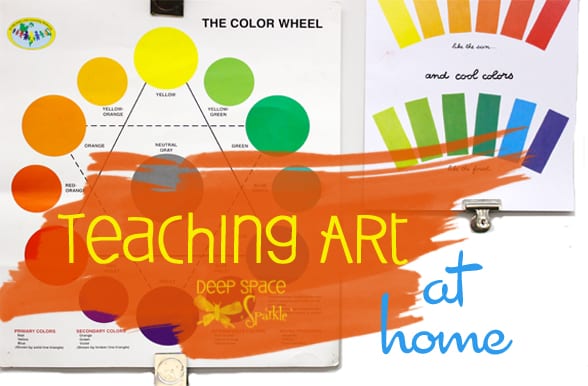











What a wonderful and motivating article.
Thank you so much.
I’m already looking forward to the next part.
Greetings,
Stephany
Great post! I do a ton of art at home with my son, but I’m definitely guilty of #3. I don’t tend to have him do projects where the set-up and/or clean-up are 10 times longer than the project itself!
My 10 year old daughter has been drawing since she could hold a crayon. She’s been self taught, I’ve never used any curriculum. She resists most conventional ways of teaching art. I’m not sure how to direct her. She is gifted artisticly and I want to nuture this love and I have usborne books and other drawing books around the house for her to look through and copy. She recently started experimenting with pencil smudging. Do you have any suggestions on what more I could do to encourage her in her art and help her get more information? Thanks:)
Your daughter is a great example of how you shouldn’t try to judge what she does. Allow her to draw and create in her own way (just like I did!) and if you want to expand her art horizons, sign her up for an art class at your local museum. You’re lucky. You don’t have to do a thing to nurture her creativity…just keep supplying the paper and pencils!
My children (7 and 10) thoroughly enjoy the projects on your site. They are homeschooled but they take art at school and do projects at home. My son and I did the tropical fish watercolor today, in fact. We’ve also done the birch tree/bird collage project and the snowy day pastel as well. So much fun! Thank you!
Yay! I love that you’re doing this!!! Pinning now…
Thank you so much for this post!!! I am a homeschooling mom and I appreciate you thinking of us:)
What do you feel about the Monart method (Mona Brooks?)
I have a soft spot for this book. I read it cover to cover the night before my first art class. I love her approach to drawing and it has really influenced my whole teaching philosophy. It’s recommended reading in my e-course.
THANKS so much for taking the time to do this series! I’m a homeschooling mom of 3 and have followed and loved your site for quite a while now. We’ve incorporated many of your projects into our curriculum, and so appreciate your perspective on how to hone our art education. Again, thanks for sharing your insight and skill with those of us who aren’t terribly artistically gifted! =)
I became a member this month and am thrilled. Maybe OVER THRILLED! I want to read everything, try everything, watch every video etc.! Thank you!
So excited for you. Make sure you login to the private Sparkler website…you can click ENTER THE SPARKLES CLUB in the menu bar. Enjoy!
I am an art teacher. Kids & adults
Drawing-painting
Thank you, very inspiring! I do wonder if a need a special permit (from the city) to teach art from home?
You can contact your local chamber of commerce to find out the details for your area. You might also want to join our free facebook group to see if their are any other art teachers in your area that are doing what you would like. Here’s a link to join:https://www.facebook.com/groups/DSSstudents/